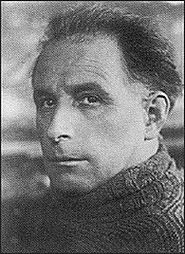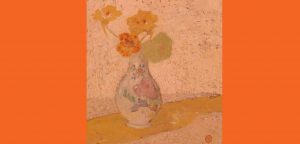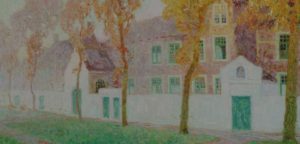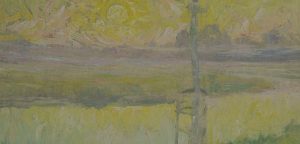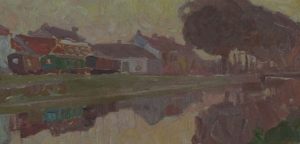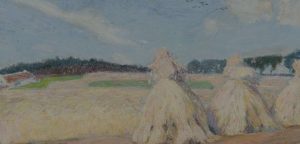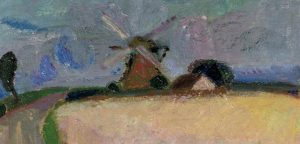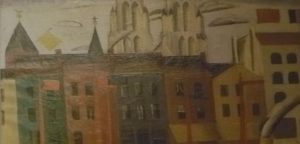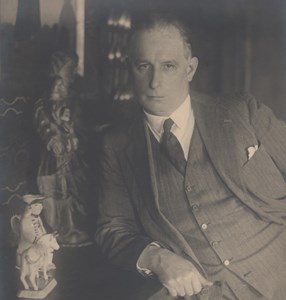Gustave de Smet was born on the 21st of January in 1877 in Ghent.
1877 - 1943
Gustave de Smet
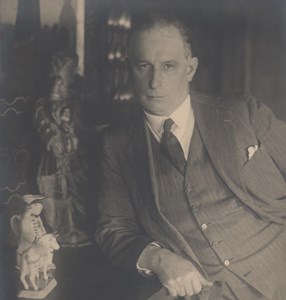
description
An outstanding Belgian artist and draftsman, who created his works primarily in the styles of impressionism, including luminism, and expressionism. He worked in the genres of landscape, rural subjects, carnival and circus scenes, still life, nude, and also performed wood engravings.
Born into the family of painter J. F. de Smet. At first, he learned painting from his father, creating decorative panels, signs, frescoes for theaters, shops, hotels and country houses with his brother Leon.
Gustave de Smet was an active member of the Lateme School (the second Expressionist wave), which had a particularly powerful impact on the development of all contemporary painting in Belgium. He was also an active member of Le Groupe des IX (The Group of Nine), an influential art community in Antwerp and the Centaur group in Brussels.
Key ideas:
– Originally, the works by Gustave de Smet consisted of landscapes of the banks of the River Lees, fields and gardens. Many of them can be attributed to impressionistic – the artist sought the presence of light and air. They also demonstrated the knowledge of the theory of luminescence with its special distribution of light effects, reminiscent of French pointillism.
– Before going to the Netherlands in 1914, Gustave de Smet had the necessary prerequisites for the realization of art, aimed primarily at expressing emotion. Later, the artist began to extensively depict the elements of nature in landscapes; genre scenes borrowed from the circus world and the life of the villagers, applying rigid contours that express tension.
– By the 1920s, the time of his return to Belgium, the artist’s paintings show a tendency to the greater geometry, to a combination of contrasting colors, more often dark shades, indicating the influence of Post-cubism or Constructivism, as seen in the canvas “View of Amsterdam”.
– Herewith, the specific language of engraving by Gustav de Smith is tending towards folk art. It is obvious that the way of composition and the expressive possibilities of the line are dictated by the style of art nouveau and by Japanese engravings that were still fashionable in Europe. The search for such a consolidation of a form and a color meant for Smet a complete rejection of Impressionism and luminism. The artist’s palette also changed. In the paintings “A Man with a Bottle” (1920, private collection), he uses a minimum of the variety of gamma, but there are at least a dozen brown shades.
– In the 30s, the artist made works in pastoral themes and manner, which is conditioned his the desire to convey an atmosphere where man and nature are harmonious and acquire an eternal character. His palette offers tones and typical for the author halftone chords, as formal searches gave a way to the increased sensitivity to colors. At that time, the master tended to depict figures (“Couple in the village”) and returned to nude, without losing interest in rural characters and still lifes.
– It’s interesting to compare three paintings under the same name “Port Ostend”. The canvas, created in 1913, gives a romantic mood with its “blurriness” of the outlines of objects, and “Le port d’Ostende” made in 1922 and in 1925 are clear urban landscapes, as if a megacity grew in a fishing village in 10 years.
1877
1889 - 1898
1906
1909
1914
1920
1927 - 1930
1930
1943
The birth of the artist
Began to study at the Art Academy of Ghent
Began to study at the Art Academy of Ghent with L. Titgat, who also became a prominent figure in the Belgian Expressionist circles. He painted landscapes and still lifes in a romantic and realistic style. At the Ghent Academy, there was a circle of young artists who were influenced by painter E. Klaus and worked at a colony in Sint-Martens-Latem near Ghent. Gustave married Augusta Van Horebeke and the young family soon left Ghent.
Moved with his family to Latham
For the first time, impressionistic elements emerged in the paintings by the artist. He and his friend K. Permeke rented a workshop in the port area of Ostend, where they created many sketches of fishing boats, as well as views of the harbor and the sea. Moved with his family to Latham, where soon the group of innovators and like-minded people, the so-called second generation of the Lateme School, was formed. In the manifesto, they described the common desire for the latest techniques in painting.
The theme of the work remained largely the same - landscape
Artist’s brother Leon de Smet joined the Lateme group. Gustave revised his views, and symbolic tendencies peculiar to the first wave of the Latemean school appeared in his works. At the same time, the theme of the work remained largely the same – landscape.
The artist distanced himself more and more from Impressionism
During the war, Gustave and his friends Berge and Ridder took refuge in Holland, where they contacted “The Falconer” and Dutch artists Slojters, Torop, Gestel from the groups “Hollandsche Kunstenaarskring” and “Het Sienjaal”. The artist distanced himself more and more from Impressionism. He got carried away by Art Nouveau and fell under the influence of German Expressionism, having met K. Schmidt, E. Kirchner and E. Heckel – the founders of the Bridge group. Got acquainted with the art of martyrs who died in the war, Expressionists F. Mark and A. Make – representatives of the “Blue Rider”, and adopted some methods of Constructivism.
Signed a contract with art dealer Arthur van Hecke
Signed a contract with art dealer Arthur van Hecke (gallery “Centaur” in Brussels). Exhibited his works in Amsterdam. Returning to Belgium and settling in Ostend, he worked in the Dutch style.
The family finally moved to the village of Durle
The family finally moved to the village of Durle. The artist became a member of the group of Contemporary Art in Antwerp, the society “Groupe des IX” (Group of nine) and the group “Centaur” in Brussels. Settled in Durle (he built the house on the banks of the River Lys), he created lively landscapes, stories from the life of the Flemish village. The works of this time were made under the influence of the artists of the Montparnasse group (Delaunay and others): the artist used the techniques of schematic Cubism in works mainly devoted to the life of the peasants.
His propensity to depict rural characters increased
His propensity to depict rural characters increased; his interest in the genre of nude and still lifes also returned. In 1936, in the Palace of Arts, there was a large retrospective exhibition of the artist’s works, characterized by critics as Expressionistic.
The death of the artist
He passed away on the 8th of October in 1943 in the village of Deurle, East Flanders.

